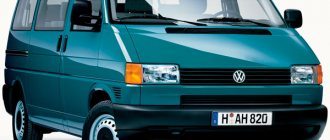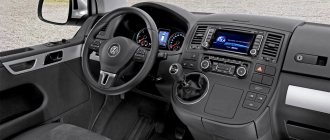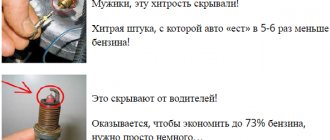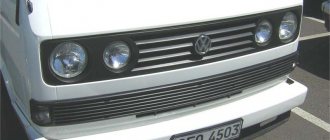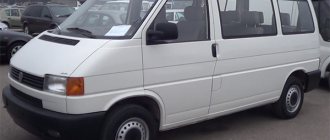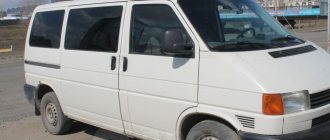After the 4th series of the modified Volkswagen Transporter was discontinued in 2003, the new Volkswagen Transporter T5 was released, which could boast both new improved characteristics and some retained old ones. As a result, we again saw the directions that came to us from the last series:
- Passenger Transportation;
- cargo and passenger transportation;
- freight transportation.
The changed technical characteristics allowed us to take a fresh look at the car presented to the general public. What has changed?
A lot of things:
- improved optics;
- increased tightness in the cabin, eliminated increased noise;
- increased carrying capacity by 180-300 kg;
- provided the opportunity to transport cargo with a trailer weighing up to 2.5 tons;
- increased overall dimensions by 20-30 cm;
- the cargo modification had swing gates;
- made a low landing to facilitate unloading and loading things;
- Installed a side sliding door for easy unloading.
Overall dimensions of Volkswagen Transporter T5
The standard Volkswagen Transporter T5 has the following cargo compartment dimensions:
- length 4890 mm;
- height 1945 mm;
- width 1905 mm.
The carrying capacity of commercially available trucks also varies and is:
- 2600 kg;
- 2800 kg;
- 3000 kg;
- 3200 kg.
The dimensions of the Volkswagen Transporter T5 affect the body options, as can be seen from the table:
| Height, mm | Length, mm | Width, mm | Load capacity, weight, kg | |
| multivan | 1970 | 4892 | 1904 | 3000 |
| Caravelle Minibus | 1990 | 4892 | 1904 | 2600-2800 |
| Transporter flatbed truck | 1990 | 5292 | 1904 | 2800-3000 |
| Transporter Chassis | 1952-1963 | 4892-5292 | 1904 | 2800-3200 |
| Van. | 1940 | 5292 | 1904 | 2800 |
Permanent all-wheel drive
Content
A bus with permanent all-wheel drive has a so-called visco clutch between the front and rear axles. This clutch performs two tasks: 1. It distributes the power flow between the rear and front axles. 2. Equalizes small differences in the number of axle revolutions.
When turning, there are different numbers of rotations of the wheels of the front and rear axles. Therefore, the distribution of forces must be flexible.
A visco clutch consists of a box filled with silicone oil that contains two friction discs that fit tightly together, with no mechanical connection between them. The discs are alternately connected to the driveshaft and the drive shaft of the front axle. The force closure occurs through viscous silicone oil, which reacts to differences in the number of revolutions between the discs. The difference in the number of revolutions between the rear and front axle causes the same difference in the number of revolutions of the discs. The greater the difference in speed, the more energy is transferred from the rear to the front axle. The engagement of the front wheels occurs softly and is practically unnoticed by the driver.
On a normal, dry road, all wheels rotate at almost the same speed. Almost all the drive energy is then absorbed by the rear axle. If, on a bad road, the rear wheels rotate slightly slower than the front wheels, then the visco clutch immediately transfers more energy to the front axle. If the rear wheels turn, almost all the traction is transferred to the front wheels.
Chassis
The independent front suspension in the Transporter, which is designed for transporting goods, is reinforced with a subframe.
A spring suspension is installed at the rear. The stiffness of the suspension depends on the parameters of the car. In addition, the rear axle had to be strengthened with an anti-roll bar. The car is equipped with a disc brake system. The built-in ABS in the front is well ventilated. Front-wheel drive design is installed in the basic Transporter models. There is the possibility of a reinforced configuration, in which all-wheel drive is provided by a built-in viscous coupling, which is very noticeable when slipping, on uneven terrain, etc. The disadvantage of such an update is considered to be the non-repairability of the installed unit, which in the event of a breakdown will have to be completely replaced. However, with timely repairs and replacement of worn parts, a complex chassis should not cause problems. Major repairs in most cases are required after a mileage of 150 thousand km. Be prepared to fork out a lot of money, because... The parts for this car are not cheap.
With a mileage of 100-200 thousand km, you will definitely have to replace the rear wheel bearings, and after another 100-200 thousand km, change the front ones.
Depending on the selection of suspension components, you can get several Multivan options:
- lifting van;
- sports van;
- comfortable bus.
It is also worth monitoring the condition of such parts as:
- shock absorbers, which can both become loose and create leaks;
- drive shafts;
- springs;
- steering rack;
- brakes that require frequent upgrades.
All-wheel drive Volkswagen Rockton and PanAmericana in German mud
Regular readers, looking at the picture at the beginning of the article, will remember: something similar has already been published in Auto Review! That’s right, in 2014 we tested the all-wheel drive Volkswagen Transporter 4MOTION at the Dmitrovsky training ground. This model, only of the new T6 series, remains in the program, and in Germany I drove more expensive versions with all-wheel drive: Transporter Rockton and Multivan PanAmericana.
When we say “all-wheel drive,” we mean the Volkswagen Nutzfahrzeuge division! Of the 477,000 commercial Volkswagens sold worldwide last year, 88,500 were equipped with the company's 4MOTION transmission, and half of these were Transporter/Multivan.
We also have such machines: let’s say, Sberbank operates cash-in-transit Transporters with all-wheel drive. The Russian online configurator also contains versions that I drove through the German forest - Transporter Rockton and Multivan PanAmericana. What are they?
PanAmericana is a lady of high society: there are shiny linings on the sides, an interior with two-tone Nappa leather upholstery, three-zone climate control, advanced multimedia and other pleasures of life. This is a full-fledged minibus, and even with a transformable interior: the seats and even a custom table move on a slide, and the interior can be turned into a coupe by turning some of the seats rearward. Well, this doesn’t surprise us: a similar performance of Riviera is proposed for Gaz’s Barguzin.
The ground clearance of the Multivan PanAmericana 4MOTION is only 2 cm greater than that of a regular Multivan
All-wheel drive (PanAmericana can be had without it) is offered only for cars with 140 and 180 hp turbodiesels. or with the most powerful, 204-horsepower gasoline engine. For a short trip through the German forest, I got just the 180-horsepower version with the DSG “robot”. On a normal road, it behaves no differently from a regular Multivan, and the sound insulation here is even better than that of the Caravelle, which I tested at the Finnish Arctic test.
Contrast in the PanAmerican cabin: leather seats and aluminum floor covering
The dirt road with shallow (so that journalists would not get stuck!), but slippery ruts also caused almost no problems: when slipping, the Haldex clutch quickly connected the wheels, which clung to the ground. True, a couple of times I touched small stones and sticks with the light-alloy protection of the power unit: the ground clearance is increased here, compared to the Multivan, by only two centimeters.
Do you know how much they ask us for this very protection? 205 thousand rubles, despite the fact that the all-wheel drive itself costs 200 thousand! And the price of the car itself is appropriate, from 3.5 million. And the cost of the version that I drove exceeds the 5 million mark. Yes, you won’t even be able to drive this one onto the ground: you’ll scratch it some more...
Transporter Rockton is easily distinguished by its ground clearance, increased to 245 mm
With Rockton, everything is not so critical: firstly, because it is not so incredibly expensive, from 2 million 550 thousand rubles (a regular Transporter Kombi is about two million). And secondly, this car is designed for more serious off-road use: the ground clearance is 245 mm versus 193 for the PanAmerican, the suspension has reinforced springs and shock absorbers, the rear differential lock is no longer an option, but standard equipment.
Alloy engine and transmission protection costs 205 thousand rubles
Rockton comes to Russia only with a 140-horsepower turbodiesel and a six-speed manual transmission, while I drove a similar, but 150-horsepower car.
Sitting behind the wheel is as comfortable as in the PanAmerican, but the situation is clearly simpler: climate control is not available even upon request, you will have to pay extra for an airbag for the passenger and for side “curtains”. Even “music” was included in the list of options, not to mention adaptive cruise control.
The interior (my version was a “semi-truck”, with one row of seats) is even more ascetic: if you don’t take into account the ashtray and a lone lamp on the ceiling, there are no additional amenities here at all. And in order to move each of the three interior seats on the slide (they are separate), you must first loosen and then tighten back 12 bolts.
On asphalt, the Rockton is downright rough. The pedals are hard, the force on the steering wheel due to the “toothy” wheels is too high, and the roll in corners is noticeable. But its element is off-road: the diesel pulls almost from idle, forgiving mistakes in switching, the moderately stiff suspension confidently swallows holes and potholes, and on long descents you can turn on the speed control function. As a result, where I sneaked on PanAmerican, afraid that the ruts would be too deep, on Rockton I drove calmly and even had time to look at the nature around me.
The conclusion will be short: the cars are thoroughbred (we already used this word in the Arctic test), but they are expensive, and sometimes very expensive. But since they are offered here, apparently there are buyers.
Engine and gearbox T5
Volkswagen Transporter T5 engines have an expanded range of petrol and diesel options.
Gasoline engines:
- with a volume of 2.0 they have a power of 115 horsepower and acceleration in 17.8 seconds to 100 km.
- with a volume of 3.2 they have a power of 235 horsepower and acceleration to 100 km in 10.5 seconds.
Diesel units:
- with a volume of 1.9 liters are available with power options of 84, 86, 102 and 105 horsepower;
- with a volume of 2.5 liters are produced with power from 131 to 174 horsepower.
Also, after certain modifications, you can find a turbodiesel with a volume of 2.0 liters and a power of 84, 102, 140 and 180 horsepower.
For different driving modes, two different types of transmission are installed, which affect fuel consumption:
- for high-speed cars it is a 6-speed manual transmission;
- standard ones have a 5-speed manual transmission.
For Transporter T5 fuses, 2 zones are allocated:
- in the cabin there are elements responsible for sensors and internal devices;
- in the engine compartment there are elements responsible for movement (brake locking system, pump and motor).
Technical characteristics of Volkswagen Transporter
During its existence (and this is no more or less, almost 70 years), the Volkswagen Transporter has survived six generations, and by 2018 it is available in trim levels with four main body types:
- kastenwagen - all-metal van;
- combi - passenger van;
- fahrgestell - two-door or four-door chassis;
- Рritschenwagen - pickup truck.
The 2018 VW Transporter is available in pickup, van, and chassis body styles
The car with the T6 index was presented to the general public in 2015 in Amsterdam. Volkswagen has not changed its tradition of not making any revolutionary changes to the exterior of the subsequent generation: the body geometry is formed by straight lines, most of the design details are regular rectangles, and yet the car looks quite stylish and solid. The designers maintained the corporate style of Volkswagen, complementing the appearance of the Transporter with laconic chrome elements, expressive lighting fixtures, and proportions thought out to the smallest detail. Visibility has been somewhat improved, the wheel arches have been enlarged, and the exterior mirrors have been modified. At the rear, attention is drawn to the large rectangular glass, vertical headlights, and a powerful bumper decorated with a shiny molding.
The design of the new Volkswagen Transporter Kombi features improved visibility and larger wheel arches
Interior and exterior of VW Transporter
The multi-purpose VW Transporter T6 Kombi provides two wheelbase versions and three roof heights. The interior of the T6 can be described as highly ergonomic and functional, designed in the corporate style of Volkswagen . The three-spoke steering wheel covers a clear and concise instrument panel, equipped with a 6.33-inch display. In addition to the instruments, the panel contains many compartments and niches for various small items. The interior is spacious, the quality of finishing materials is higher than that of its predecessors.
The basic modification of the minibus accommodates 9 passengers, the extended version can be supplemented with two more seats. If necessary, the seats can be removed, which will increase the cargo volume of the vehicle. The trunk door is equipped with a closer and can be made in the form of a lifting lid or hinged doors. A side sliding door is provided for passengers to board. The gearbox control lever has changed its location and is now attached to the bottom of the console.
Among the options that the basic version of the car is equipped with:
- glazing thermal protection system;
- rubberized floor;
- interior heating using rear heat exchangers;
- headlights with halogen lamps;
- power steering;
- ESP - exchange rate stability system;
- ABS - anti-lock braking system;
- ASR - anti-slip system;
- third brake light;
- turn signal repeaters;
- Air Bag - airbag in the driver's seat.
The VW Transporter interior is designed with a high degree of ergonomics and functionality
By paying extra, you can additionally order:
- full climate control;
- Cruise control;
- Park Assist;
- immobilizer;
- navigation system;
- self-adjusting headlights;
- collision braking system;
- multifunction steering wheel;
- heated front seats;
- electrically adjustable exterior mirrors;
- driver fatigue monitoring system.
I bought a Volkswagen Transporter a year ago and have been pleased with this rugged family minivan. Before that, I had a Polo, but there was an addition to the family (a second son was born). We decided it was time to upgrade our vehicle to a comfortable and smart solution for long-term family trips. My wife and I took the 2.0 TDI 4Motion L2 with diesel fuel. Even taking into account the difficulties of the situation on the roads of Russia, I was satisfied with the control of the car. Comfortable seats, climate control system, large storage space (we went on a trip for 3 weeks with children) definitely pleased us. As a result, I enjoyed the ride; driving such a car with a 6-speed gearbox leaves only pleasant impressions; I was pleased with the function of controlling all the car’s systems: you feel the car 100%, despite its size and load. At the same time, the transporter does not burn a lot of fuel, which makes it possible to make long trips regular.
A.R.S.
https://carsguru.net/opinions/3926/view.html
Dimensions of VW Transporter
If we talk about the VW Transporter Kombi model, then there are several design options for this car depending on the wheelbase size and roof height. The wheelbase can be small (3000 mm) and large (3400 mm), the roof height is standard, medium and large. By combining these combinations of dimensions, you can choose the most appropriate option for yourself . The full length of the Volkswagen Transporter can be from 4904 mm to 5304 mm, width - from 1904 mm to 2297 mm, height - from 1990 mm to 2477 mm.
The trunk volume of the standard Kombi version can be increased to 9.3 m3 by removing the unused seats. The cargo-passenger version of Kombi/Doka provides 6 passenger seats and a luggage compartment with a volume of 3.5 to 4.4 m3. The fuel tank holds 80 liters. The vehicle's carrying capacity is in the range of 800–1400 kg.
The luggage compartment volume of the VW Transporter Kombi can be increased to 9.3 m3
Power unit
In 2022, the VW Transporter will be equipped with one of three diesel or two gasoline engines. All engines are two-liter diesel engines with a capacity of 102, 140 and 180 hp. s., petrol - 150 and 204 l. With. The fuel supply system in diesel units is direct injection; gasoline engines have an injector and distributed fuel injection. Gasoline brand - A95. Average fuel consumption for the basic 2.0MT modification is 6.7 liters per 100 km.
The VW Transporter engine can be petrol or diesel
Table: technical characteristics of various modifications of the VW Transporter
| Characteristic | 2.0MT diesel | 2.0AMT diesel | 2.0AMT diesel 4x4 | 2.0MT petrol | 2.0AMT gasoline |
| Engine capacity, l | 2,0 | 2,0 | 2,0 | 2,0 | 2,0 |
| Engine power, l. With. | 102 | 140 | 180 | 150 | 204 |
| Torque, Nm/rev. per minute | 250/2500 | 340/2500 | 400/2000 | 280/3750 | 350/4000 |
| Number of cylinders | 4 | 4 | 4 | 4 | 4 |
| Cylinder arrangement | in-line | in-line | in-line | in-line | in-line |
| Valves per cylinder | 4 | 4 | 4 | 4 | 4 |
| checkpoint | 5 manual transmission | 7 automatic transmission | 7-speed robot | 6 manual transmission | 7-speed robot |
| Drive unit | front | front | full | front | front |
| Rear brakes | disk | disk | disk | disk | disk |
| Front brakes | ventilated disc | ventilated disc | ventilated disc | ventilated disc | ventilated disc |
| Rear suspension | independent, spring | independent, spring | independent, spring | independent, spring | independent, spring |
| Front suspension | independent, spring | independent, spring | independent, spring | independent, spring | independent, spring |
| Maximum speed, km/h | 157 | 166 | 188 | 174 | 194 |
| Acceleration to 100 km/h, seconds | 15,5 | 13,1 | 10,8 | 11,6 | 8,8 |
| Fuel consumption, l per 100 km (city/highway/mixed mode) | 8,3/5,8/6,7 | 10,2/6,7/8,0 | 10,9/7,3/8,6 | 12,8/7,8/9,6 | 13,2/7,8/9,8 |
| CO2 emissions, g/km | 176 | 211 | 226 | 224 | 228 |
| Length, m | 4,904 | 4,904 | 4,904 | 4,904 | 4,904 |
| Width, m | 1,904 | 1,904 | 1,904 | 1,904 | 1,904 |
| Height, m | 1,99 | 1,99 | 1,99 | 1,99 | 1,99 |
| Wheelbase, m | 3 | 3 | 3 | 3 | 3 |
| Ground clearance, cm | 20,1 | 20,1 | 20,1 | 20,1 | 20,1 |
| Wheel size | 205/65/R16 215/65/R16 215/60/R17 235/55/R17 255/45/R18 | 205/65/R16 215/65/R16 215/60/R17 235/55/R17 255/45/R18 | 205/65/R16 215/65/R16 215/60/R17 235/55/R17 255/45/R18 | 205/65/R16 215/65/R16 215/60/R17 235/55/R17 255/45/R18 | 205/65/R16 215/65/R16 215/60/R17 235/55/R17 255/45/R18 |
| Tank volume, l | 80 | 80 | 80 | 80 | 80 |
| Curb weight, t | 1,976 | 1,976 | 2,026 | 1,956 | 1,956 |
| Gross weight, t | 2,8 | 2,8 | 2,8 | 2,8 | 2,8 |
I bought this car a year and a half ago and I can say that it is a super car. Its suspension is soft, making it almost impossible to get tired while driving. The car handles well and is maneuverable on the roads, despite its size. The Volkswagen Transporter is the best-selling car in this class. Reliability, beauty and amenities are all at the highest level. We need to talk about an important advantage of a minibus on the roads: now no one will blind your view on the road at night. Every driver knows that the safety of passengers and their own is paramount.
Serbuloff
https://carsguru.net/opinions/3373/view.html
Video: what attracts the Volkswagen T6 Transporter
Transmission
The Volkswagen Transporter transmission can be a five-speed manual, six-speed automatic or 7-position DSG robot. It should be noted that a robotic gearbox is quite rare for cargo or cargo-passenger vans. However, in the Transporter, according to owner reviews, the DSG works reliably, without interruption, providing maximum fuel economy, and also providing for a sports mode that is exotic for this class of car and throttle change when reset . The designers finally managed to overcome the “jumping” behavior of such a box at low speeds in urban conditions: switching is carried out smoothly, without jerking. And yet, for most minibus owners, the absence of a gear lever is still an unusual phenomenon, and a manual transmission is more popular in this segment of vehicles.
The drive can be front-wheel drive or all-wheel drive. In the second case, the rear axle is engaged using a Haldex coupling installed in front of the rear axle. The fact that the car is all-wheel drive is indicated by the “4Motion” nameplate mounted on the radiator grille.
The VW Transporter transmission can be equipped with a manual, automatic or robotic gearbox
Chassis
The front and rear suspensions of the Volkswagen Transporter are independent springs. The front suspension type is McPherson, the rear is an isolated side hinge. The rear brakes are disc, the front brakes are ventilated, preventing overheating of the brake mechanism.
Now it’s even difficult to remember how often I change the pads. I changed the rear ones in September (about 3 years away), I changed the front ones two years ago (still 3-4mm left). I think the sensor will light up soon. The average annual mileage is 50–55 thousand. Driving style: on the highway - neatly fast (90–100 km/h), in the city - neat (my brother calls me a turtle).
Alexey190178
https://vw-transporter.ru/forum_t5/viewtopic.php?f=37&t=8330

